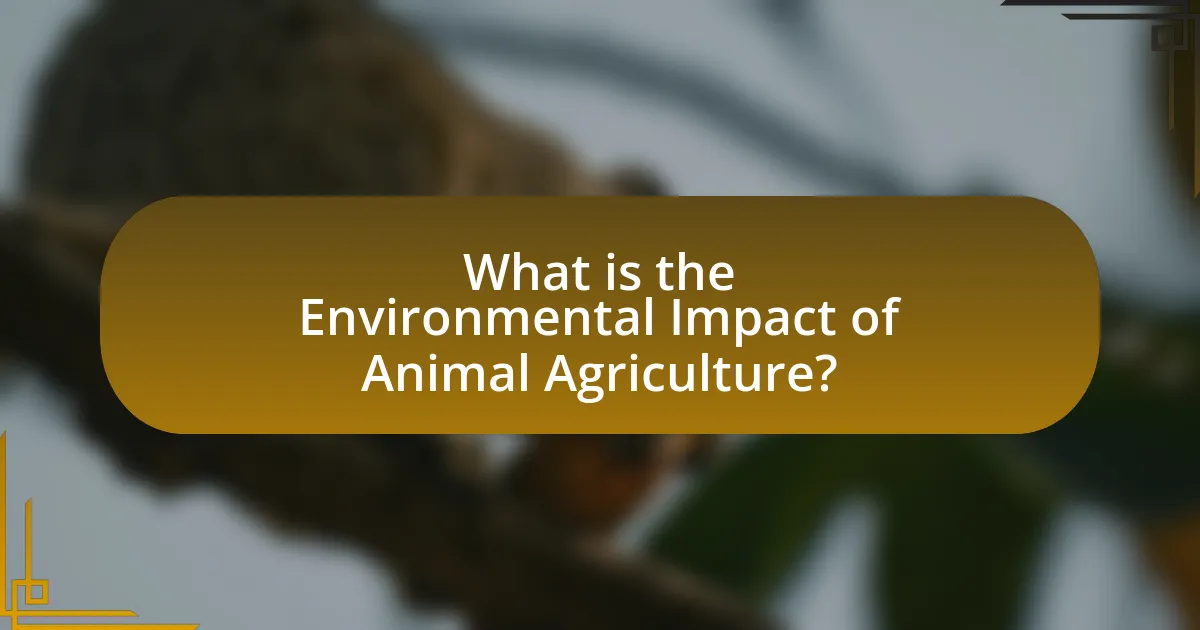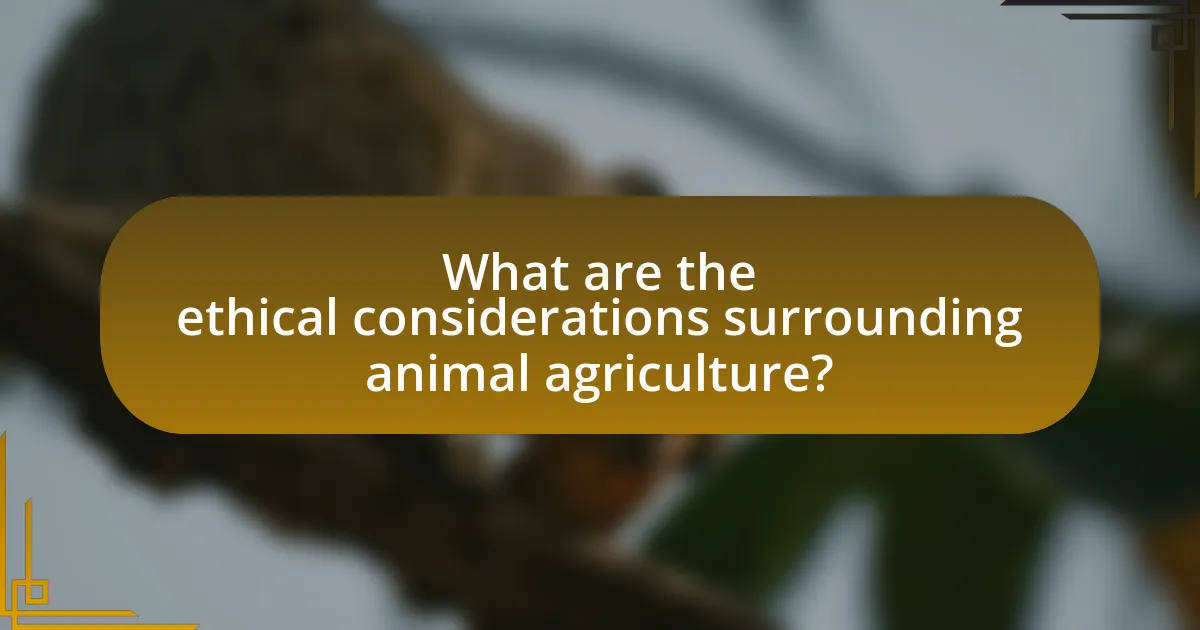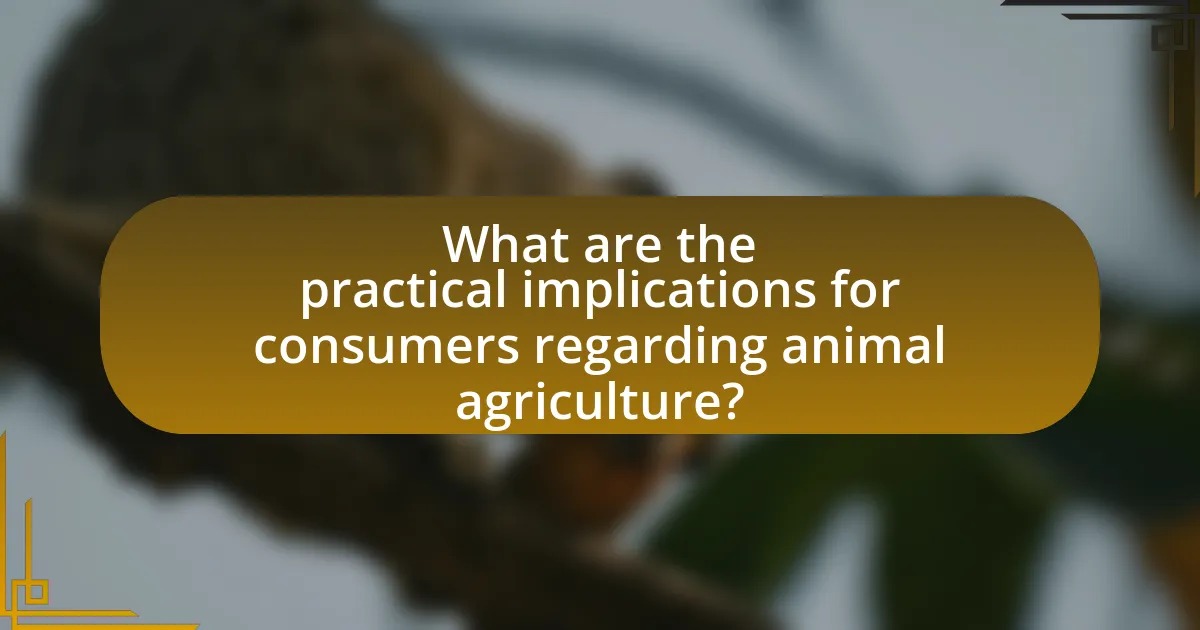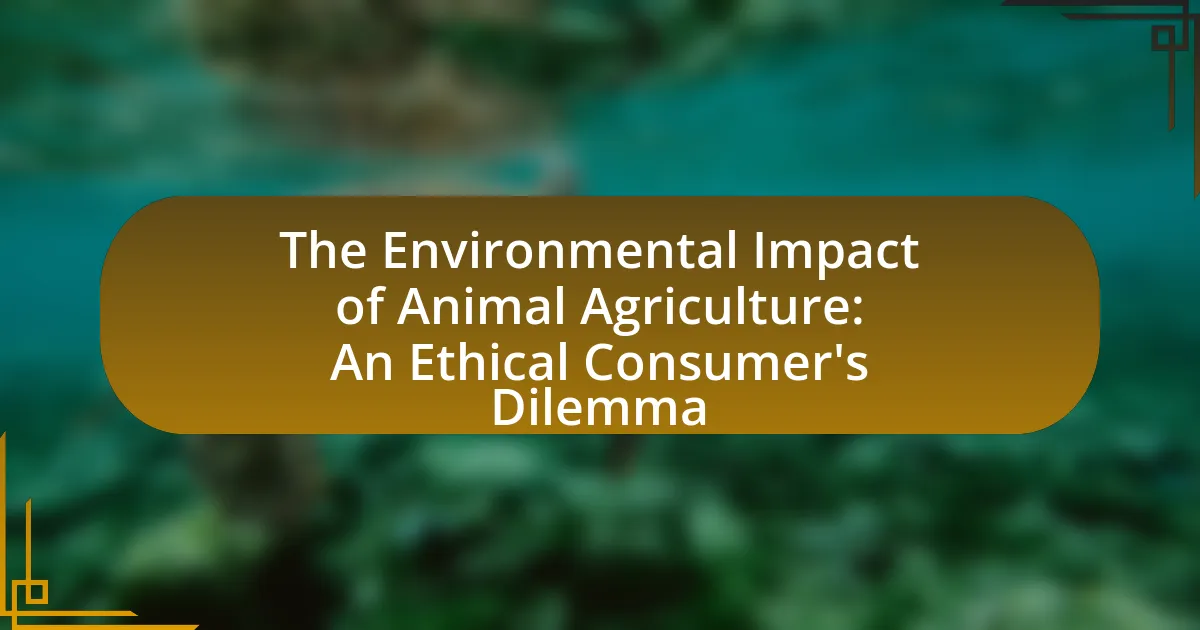The article examines the environmental impact of animal agriculture, highlighting its significant contributions to greenhouse gas emissions, deforestation, and biodiversity loss. It details how livestock farming accounts for approximately 14.5% of global greenhouse gas emissions, primarily through methane and nitrous oxide, and discusses the associated issues of water pollution and land-use change. The article also explores the ethical considerations surrounding animal agriculture, including animal welfare and human health, while emphasizing the role of consumers in influencing sustainable practices through informed choices. Additionally, it presents alternatives for ethically conscious consumers, such as plant-based diets and sustainable farming practices, and offers strategies for reducing environmental footprints.

What is the Environmental Impact of Animal Agriculture?
The environmental impact of animal agriculture is significant, contributing to greenhouse gas emissions, deforestation, and biodiversity loss. Animal agriculture is responsible for approximately 14.5% of global greenhouse gas emissions, primarily methane and nitrous oxide, which are more potent than carbon dioxide. Additionally, livestock farming leads to deforestation, as forests are cleared for grazing land and feed crops, resulting in habitat destruction and loss of biodiversity. For instance, the Food and Agriculture Organization (FAO) reports that livestock production is a major driver of land-use change, with about 70% of previously forested land in the Amazon now used for cattle ranching. This combination of emissions and land-use change underscores the substantial environmental footprint of animal agriculture.
How does animal agriculture contribute to environmental degradation?
Animal agriculture significantly contributes to environmental degradation through deforestation, greenhouse gas emissions, and water pollution. The livestock sector is responsible for approximately 14.5% of global greenhouse gas emissions, primarily methane and nitrous oxide, which are far more potent than carbon dioxide. Deforestation occurs as forests are cleared for grazing land and feed crops, leading to habitat loss and biodiversity decline; for instance, the Amazon rainforest has seen substantial deforestation linked to cattle ranching. Additionally, animal agriculture contributes to water pollution through runoff of fertilizers and waste, which contaminates waterways and disrupts aquatic ecosystems. These factors collectively illustrate the detrimental impact of animal agriculture on the environment.
What are the primary environmental issues associated with animal agriculture?
The primary environmental issues associated with animal agriculture include greenhouse gas emissions, deforestation, water usage, and biodiversity loss. Animal agriculture is responsible for approximately 14.5% of global greenhouse gas emissions, primarily methane and nitrous oxide, which are significantly more potent than carbon dioxide. Additionally, livestock farming contributes to deforestation, particularly in regions like the Amazon, where forests are cleared for pasture and feed crops, leading to habitat destruction. Water usage is another critical concern, as animal agriculture requires substantial water resources; for instance, producing one kilogram of beef can consume over 15,000 liters of water. Lastly, the expansion of animal farming threatens biodiversity, as it often leads to the displacement of wildlife and the degradation of ecosystems.
How do greenhouse gas emissions from animal agriculture compare to other sectors?
Greenhouse gas emissions from animal agriculture account for approximately 14.5% of global emissions, making it a significant contributor compared to other sectors. In contrast, the energy sector, which includes fossil fuel combustion, is responsible for about 73% of total emissions. This indicates that while animal agriculture is a major source of greenhouse gases, it is less than the energy sector, which dominates overall emissions. Additionally, the Food and Agriculture Organization (FAO) highlights that livestock production is a major driver of deforestation and land use change, further exacerbating climate change impacts.
Why is understanding the environmental impact of animal agriculture important for consumers?
Understanding the environmental impact of animal agriculture is crucial for consumers because it directly influences their purchasing decisions and lifestyle choices. Consumers who are aware of the significant greenhouse gas emissions, land degradation, and water usage associated with animal farming can make informed choices that align with their values regarding sustainability and ethical consumption. For instance, research from the Food and Agriculture Organization indicates that livestock production contributes approximately 14.5% of global greenhouse gas emissions, highlighting the substantial environmental footprint of animal agriculture. By understanding these impacts, consumers can support more sustainable practices, such as choosing plant-based diets or sourcing meat from regenerative farms, ultimately contributing to environmental conservation and climate change mitigation.
What role do consumers play in influencing animal agriculture practices?
Consumers play a crucial role in influencing animal agriculture practices by driving demand for specific products and ethical standards. Their purchasing choices can lead to significant changes in farming methods, as producers adapt to meet consumer preferences for humane treatment, sustainability, and organic practices. For instance, a 2021 survey by the American Farm Bureau Federation indicated that 70% of consumers are willing to pay more for products that are certified humane, prompting many farms to adopt higher welfare standards to capture this market. This shift demonstrates how consumer behavior directly impacts agricultural practices, encouraging transparency and ethical considerations in the industry.
How can consumer choices affect environmental sustainability?
Consumer choices significantly affect environmental sustainability by influencing demand for products that either harm or benefit the environment. When consumers opt for sustainable products, such as plant-based foods, they reduce the demand for resource-intensive animal agriculture, which is responsible for approximately 14.5% of global greenhouse gas emissions according to the Food and Agriculture Organization. Conversely, choosing products linked to deforestation, overfishing, or excessive water use exacerbates environmental degradation. Thus, informed consumer behavior can drive market shifts towards more sustainable practices, ultimately promoting environmental health.

What are the ethical considerations surrounding animal agriculture?
The ethical considerations surrounding animal agriculture include animal welfare, environmental sustainability, and human health. Animal welfare concerns arise from practices such as confinement, inhumane treatment, and the conditions in which animals are raised and slaughtered. For instance, the American Society for the Prevention of Cruelty to Animals (ASPCA) highlights that factory farming often leads to significant suffering for animals due to overcrowding and lack of natural behaviors.
Environmental sustainability is another critical ethical issue, as animal agriculture contributes to greenhouse gas emissions, deforestation, and water pollution. According to the Food and Agriculture Organization (FAO), livestock production is responsible for approximately 14.5% of global greenhouse gas emissions, which raises questions about the long-term viability of such practices in the face of climate change.
Human health is also impacted by animal agriculture, particularly through the use of antibiotics in livestock, which can lead to antibiotic resistance in humans. The Centers for Disease Control and Prevention (CDC) states that antibiotic-resistant infections are a significant public health threat, often linked to the overuse of antibiotics in animal farming.
These ethical considerations compel consumers to reflect on their choices and the broader implications of animal agriculture on society and the planet.
How do ethical concerns intersect with environmental impacts?
Ethical concerns intersect with environmental impacts primarily through the moral implications of animal agriculture practices that contribute to ecological degradation. For instance, intensive animal farming is linked to deforestation, greenhouse gas emissions, and water pollution, raising ethical questions about the treatment of animals and the sustainability of food systems. Research indicates that livestock production accounts for approximately 14.5% of global greenhouse gas emissions, highlighting the environmental consequences of these practices and prompting consumers to consider the ethical dimensions of their dietary choices. This intersection compels individuals to evaluate the moral responsibility they hold in mitigating environmental harm while addressing animal welfare.
What ethical dilemmas do consumers face when choosing animal products?
Consumers face ethical dilemmas when choosing animal products primarily related to animal welfare, environmental sustainability, and health implications. The decision to purchase animal products often conflicts with concerns about the treatment of animals in factory farming, where practices can lead to suffering and inhumane conditions. Additionally, the environmental impact of animal agriculture is significant; livestock farming contributes to greenhouse gas emissions, deforestation, and water pollution, raising questions about the sustainability of such choices. Health concerns also arise, as the consumption of certain animal products has been linked to various health issues, prompting consumers to weigh the benefits against potential risks. These dilemmas highlight the complex interplay between personal values, ethical considerations, and the broader implications of animal agriculture on society and the planet.
How do different cultural perspectives influence ethical views on animal agriculture?
Different cultural perspectives significantly influence ethical views on animal agriculture by shaping beliefs about animal rights, environmental sustainability, and dietary practices. For instance, in Western cultures, there is a growing emphasis on animal welfare and the ethical treatment of livestock, leading to movements advocating for humane farming practices and vegetarianism. In contrast, many Eastern cultures, such as those influenced by Hinduism, view cows as sacred, which fosters a strong aversion to beef consumption and promotes vegetarian diets as a moral obligation. Additionally, indigenous cultures often emphasize a holistic relationship with nature, viewing animal agriculture as part of a broader ecological system, which can lead to sustainable practices that respect animal life. These cultural frameworks dictate not only dietary choices but also the ethical considerations surrounding animal agriculture, as evidenced by varying regulations and consumer behaviors across different regions.
What alternatives exist for ethically conscious consumers?
Ethically conscious consumers can choose plant-based diets, which significantly reduce environmental impact compared to animal agriculture. Research indicates that adopting a vegan diet can lower greenhouse gas emissions by up to 70% compared to meat-based diets, as highlighted in a study published in the journal “Nature.” Additionally, consumers can support local and sustainable farms that prioritize animal welfare and environmentally friendly practices. These alternatives not only align with ethical considerations but also contribute to a more sustainable food system.
What are the benefits of plant-based diets in reducing environmental impact?
Plant-based diets significantly reduce environmental impact by lowering greenhouse gas emissions, conserving water, and preserving biodiversity. Research indicates that animal agriculture is responsible for approximately 14.5% of global greenhouse gas emissions, while plant-based diets can reduce these emissions by up to 70% when replacing meat and dairy with plant foods. Additionally, producing plant-based foods typically requires less water; for instance, producing one kilogram of beef requires about 15,000 liters of water, whereas one kilogram of lentils requires only about 1,500 liters. Furthermore, plant-based diets contribute to biodiversity preservation by reducing the land needed for livestock grazing and feed crops, which can help protect natural habitats.
How can consumers support sustainable animal farming practices?
Consumers can support sustainable animal farming practices by choosing to purchase products from farms that adhere to ethical and environmentally friendly standards. By selecting meat, dairy, and eggs from certified organic or pasture-raised sources, consumers encourage farmers to adopt sustainable practices that prioritize animal welfare and reduce environmental impact. Research indicates that organic farming can lead to a 30% reduction in greenhouse gas emissions compared to conventional farming methods, highlighting the positive environmental effects of such choices. Additionally, consumers can advocate for transparency in labeling and support local farms that practice sustainable methods, further promoting a shift towards more responsible animal agriculture.

What are the practical implications for consumers regarding animal agriculture?
Consumers face several practical implications regarding animal agriculture, primarily related to health, environmental sustainability, and ethical considerations. Health-wise, the consumption of animal products has been linked to various health issues, including heart disease and antibiotic resistance, as a significant portion of livestock is treated with antibiotics. Environmentally, animal agriculture is responsible for approximately 14.5% of global greenhouse gas emissions, contributing to climate change and resource depletion, which consumers must consider when making dietary choices. Ethically, consumers are increasingly confronted with the welfare of animals in factory farming systems, prompting many to seek alternatives such as plant-based diets or ethically sourced animal products. These implications necessitate informed decision-making by consumers, influencing their purchasing habits and dietary preferences.
How can consumers make informed choices about animal products?
Consumers can make informed choices about animal products by researching the sourcing, production methods, and environmental impacts associated with these products. Understanding labels such as “grass-fed,” “free-range,” and “organic” helps consumers identify more sustainable options. Studies indicate that animal agriculture significantly contributes to greenhouse gas emissions, with livestock accounting for approximately 14.5% of global emissions, according to the Food and Agriculture Organization. Additionally, consumers can consult resources like the Environmental Working Group or the World Wildlife Fund, which provide insights into the ecological footprint of various animal products. By prioritizing transparency and sustainability, consumers can align their purchasing decisions with ethical and environmental considerations.
What labels and certifications should consumers look for when purchasing animal products?
Consumers should look for labels and certifications such as USDA Organic, Certified Humane, Animal Welfare Approved, and Grass-Fed when purchasing animal products. USDA Organic certification ensures that animals are raised without synthetic pesticides or fertilizers, promoting environmentally sustainable practices. Certified Humane indicates that animals are treated with care and respect, meeting specific welfare standards. Animal Welfare Approved signifies that animals are raised on farms that adhere to high welfare standards, while Grass-Fed certification confirms that animals have been fed a natural diet of grass, which can lead to lower environmental impact compared to grain-fed systems. These certifications provide assurance of ethical treatment and sustainable practices in animal agriculture.
How can consumers balance ethical considerations with personal dietary preferences?
Consumers can balance ethical considerations with personal dietary preferences by adopting a flexible approach that incorporates both ethical sourcing and personal taste. This can be achieved by prioritizing plant-based options, which have a lower environmental impact, while still allowing for occasional consumption of animal products sourced from sustainable and humane practices. Research indicates that reducing meat consumption by even a small percentage can significantly decrease one’s carbon footprint, as animal agriculture is responsible for approximately 14.5% of global greenhouse gas emissions according to the Food and Agriculture Organization. By making informed choices, such as selecting local, organic, or certified humane products, consumers can align their dietary habits with their ethical values while still enjoying their preferred foods.
What strategies can consumers adopt to minimize their environmental footprint?
Consumers can minimize their environmental footprint by adopting plant-based diets, reducing food waste, and choosing sustainable products. A plant-based diet significantly lowers greenhouse gas emissions, as animal agriculture is responsible for approximately 14.5% of global emissions according to the Food and Agriculture Organization. Reducing food waste, which accounts for about one-third of all food produced, can further decrease the environmental impact by conserving resources used in food production. Additionally, selecting products with eco-friendly certifications, such as organic or fair trade, supports sustainable practices and reduces reliance on harmful agricultural methods.
How can meal planning and preparation contribute to sustainable eating habits?
Meal planning and preparation can significantly contribute to sustainable eating habits by reducing food waste and promoting the consumption of plant-based foods. By organizing meals in advance, individuals can purchase only the necessary ingredients, minimizing excess and spoilage. According to the Food and Agriculture Organization, approximately one-third of all food produced globally is wasted, which has a substantial environmental impact, including greenhouse gas emissions. Furthermore, meal preparation encourages the inclusion of more plant-based options, which are generally more sustainable than animal products. Research indicates that shifting towards a plant-based diet can reduce an individual’s carbon footprint by up to 50%. Thus, effective meal planning and preparation not only enhance personal health but also support environmental sustainability.
What are some tips for reducing meat consumption without sacrificing nutrition?
To reduce meat consumption without sacrificing nutrition, individuals can incorporate plant-based protein sources such as legumes, nuts, and whole grains into their diets. These alternatives provide essential nutrients like protein, fiber, vitamins, and minerals. For instance, lentils offer about 18 grams of protein per cooked cup, while quinoa contains all nine essential amino acids, making it a complete protein source. Additionally, replacing meat with vegetables in meals can enhance nutrient diversity; for example, using mushrooms or eggplant can add umami flavor and texture. Research indicates that a balanced diet rich in fruits, vegetables, and whole grains can meet nutritional needs while reducing meat intake, as supported by the American Dietetic Association’s position on vegetarian diets.
